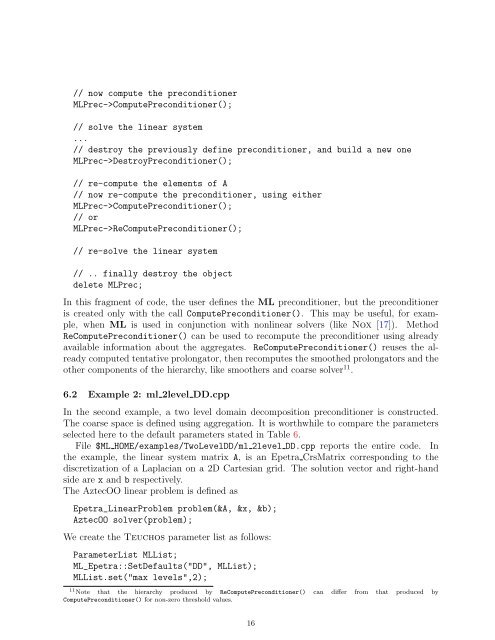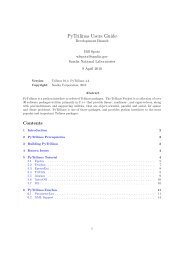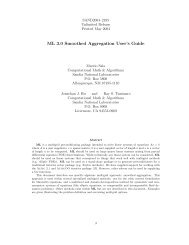nonsymmetric dynamics
ML 5.0 Smoothed Aggregation User's Guide - Trilinos - Sandia ...
ML 5.0 Smoothed Aggregation User's Guide - Trilinos - Sandia ...
- No tags were found...
You also want an ePaper? Increase the reach of your titles
YUMPU automatically turns print PDFs into web optimized ePapers that Google loves.
now compute the preconditioner<br />
MLPrec->ComputePreconditioner();<br />
// solve the linear system<br />
...<br />
// destroy the previously define preconditioner, and build a new one<br />
MLPrec->DestroyPreconditioner();<br />
// re-compute the elements of A<br />
// now re-compute the preconditioner, using either<br />
MLPrec->ComputePreconditioner();<br />
// or<br />
MLPrec->ReComputePreconditioner();<br />
// re-solve the linear system<br />
// .. finally destroy the object<br />
delete MLPrec;<br />
In this fragment of code, the user defines the ML preconditioner, but the preconditioner<br />
is created only with the call ComputePreconditioner(). This may be useful, for example,<br />
when ML is used in conjunction with nonlinear solvers (like Nox [17]). Method<br />
ReComputePreconditioner() can be used to recompute the preconditioner using already<br />
available information about the aggregates. ReComputePreconditioner() reuses the already<br />
computed tentative prolongator, then recomputes the smoothed prolongators and the<br />
other components of the hierarchy, like smoothers and coarse solver 11 .<br />
6.2 Example 2: ml 2level DD.cpp<br />
In the second example, a two level domain decomposition preconditioner is constructed.<br />
The coarse space is defined using aggregation. It is worthwhile to compare the parameters<br />
selected here to the default parameters stated in Table 6.<br />
File $ML HOME/examples/TwoLevelDD/ml 2level DD.cpp reports the entire code. In<br />
the example, the linear system matrix A, is an Epetra CrsMatrix corresponding to the<br />
discretization of a Laplacian on a 2D Cartesian grid. The solution vector and right-hand<br />
side are x and b respectively.<br />
The AztecOO linear problem is defined as<br />
Epetra_LinearProblem problem(&A, &x, &b);<br />
AztecOO solver(problem);<br />
We create the Teuchos parameter list as follows:<br />
ParameterList MLList;<br />
ML_Epetra::SetDefaults("DD", MLList);<br />
MLList.set("max levels",2);<br />
11 Note that the hierarchy produced by ReComputePreconditioner() can differ from that produced by<br />
ComputePreconditioner() for non-zero threshold values.<br />
16







